
Frumenty was a popular dish in Western European medieval cuisine. It is a porridge, a thick boiled grain dish—hence its name, which derives from the Latin word frumentum, "grain". It was usually made with cracked wheat boiled with either milk or broth and was a peasant staple. More luxurious recipes include eggs, almonds, currants, sugar, saffron and orange flower water. Frumenty was served with meat as a pottage, traditionally with venison or even porpoise. It was also frequently used as a subtlety, a dish between courses at a banquet.
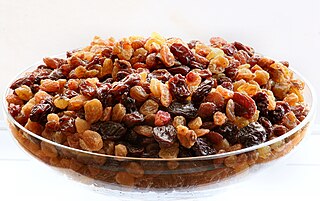
A raisin is a dried grape. Raisins are produced in many regions of the world and may be eaten raw or used in cooking, baking, and brewing. In the United Kingdom, Ireland, New Zealand, Australia and South Africa, the word raisin is reserved for the dark-colored dried large grape, with sultana being a golden-colored dried grape, and currant being a dried small Black Corinth seedless grape.

Mulled wine, also known as spiced wine, is an alcoholic drink usually made with red wine, along with various mulling spices and sometimes raisins, served hot or warm. It is a traditional drink during winter, especially around Christmas. It is usually served at Christmas markets in Europe, primarily in Germany, Austria, Switzerland, Croatia, Romania, Nordics, Baltics and eastern France. There are non-alcoholic versions of it. Vodka-spiked mulled wine can be found in Polish Christmas markets, where mulled wine is commonly used as a mixer.
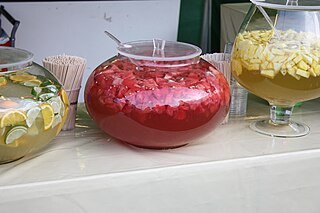
The term punch refers to a wide assortment of drinks, both non-alcoholic and alcoholic, generally containing fruits or fruit juice. The drink was introduced from the Indian subcontinent to England by employees of the East India Company in the late 17th century. Punch is usually served at parties in large, wide bowls, known as punch bowls.
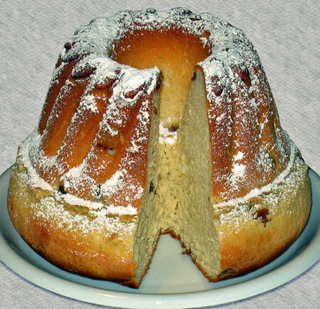
A Gugelhupf (also Kugelhupf, Guglhupf, Gugelhopf, pronounced[ˈɡuːɡl̩.hʊp͡f,-hɔp͡f,ˈkuːɡl̩-], and, in France, kouglof, kougelhof, or kougelhopf, is a cake traditionally baked in a distinctive ring pan, similar to Bundt cake, but leavened with baker's yeast.

Eggnog, historically also known as a milk punch or an egg milk punch when alcoholic beverages are added, is a rich, chilled, sweetened, dairy-based beverage. It is traditionally made with milk, cream, sugar, egg yolks, and whipped egg whites. A distilled spirit such as brandy, rum, whiskey or bourbon is often a key ingredient.

A cacodemon is an evil spirit or a demon. The opposite of a cacodemon is an agathodaemon or eudaemon, a good spirit or angel. The word cacodemon comes through Latin from the Ancient Greek κακοδαίμων kakodaimōn, meaning an "evil spirit", whereas daimon would be a neutral spirit in Greek. It is believed to be capable of shapeshifting. A cacodemon is also said to be a malevolent person.

Dutch cuisine is formed from the cooking traditions and practices of the Netherlands. The country's cuisine is shaped by its location in the fertile North Sea river delta of the European Plain, giving rise to fishing, farming and overseas trade. The Burgundian-Habsburg court enriched the cuisine of the Dutch elite in the 15th and 16th century, so did the colonial spice trade in the 17th century.

Brandy & Mr. Whiskers is an American animated television series created by sitcom writer Russell Marcus for the Disney Channel. It follows the lives of the titular characters—respectively, a pampered-yet-spunky dog and a hyperactive rabbit—who get stuck in the Amazon Rainforest together. The show originally aired from August 21, 2004, to August 25, 2006. Thirty-nine episodes were produced.

Flambé is a cooking procedure in which alcohol is added to a hot pan to create a burst of flames. The word means "flamed" in French.
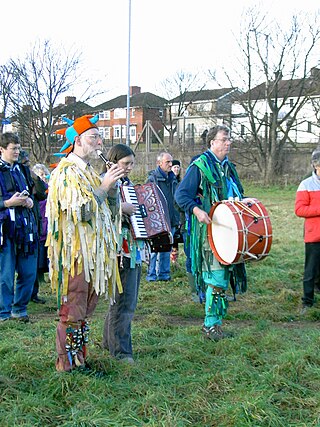
The tradition of wassailing falls into two distinct categories: the house-visiting wassail and the orchard-visiting wassail. The house-visiting wassail is the practice of people going door-to-door, singing and offering a drink from the wassail bowl in exchange for gifts; this practice still exists, but has largely been displaced by carol singing. The orchard-visiting wassail refers to the ancient custom of visiting orchards in cider-producing regions of England, reciting incantations and singing to the trees to promote a good harvest for the coming year. Notable traditional wassailing songs include "Here We Come a-Wassailing", "Gloucestershire Wassail", and "Gower Wassail".
"We Wish You a Merry Christmas" is an English Christmas carol, listed as numbers 230 and 9681 in the Roud Folk Song Index. The famous version of the carol is from the English West Country.
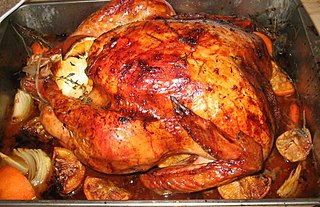
Christmas dinner is a meal traditionally eaten at Christmas. This meal can take place any time from the evening of Christmas Eve to the evening of Christmas Day itself. The meals are often particularly rich and substantial, in the tradition of the Christian feast day celebration, and form a significant part of gatherings held to celebrate the arrival of Christmastide. In many cases, there is a ritual element to the meal related to the religious celebration, such as the saying of grace.

Christmas in Ireland is the annual festival which marks the Christian celebration of the birth of Jesus and its related observances, but also incorporates some pre-Christian customs. These customs range from the traditional food and drink consumed, decorations and rituals, as well as more modern phenomena such as the Christmas day swim and annual television and radio events. The modern Irish Christmas has become more similar to that of the British and American festive period, with emphasis on gift buying and parties.
Hot potato is a party game that involves players gathering in a circle and tossing a small object such as a beanbag or even a real potato to each other while music plays. The player who is holding the object when the music stops is eliminated.

Christmas is celebrated throughout December and traditionally until St. Knut's Day on January 13. The main celebration and the exchange of gifts in many families takes place on Christmas Eve, December 24. The Feast of St. Lucy, a high point in the Swedish Christmas season, is celebrated during Advent, on December 13.

The Good Huswifes Jewell is an English cookery book by the cookery and housekeeping writer Thomas Dawson, first published in 1585. It includes recipes for medicines as well as food. To the spices found in Medieval English cooking, the book adds herbs, especially parsley and thyme. Sugar is used in many of the dishes, along with ingredients that are uncommon in modern cooking like violets and rosewater.

















